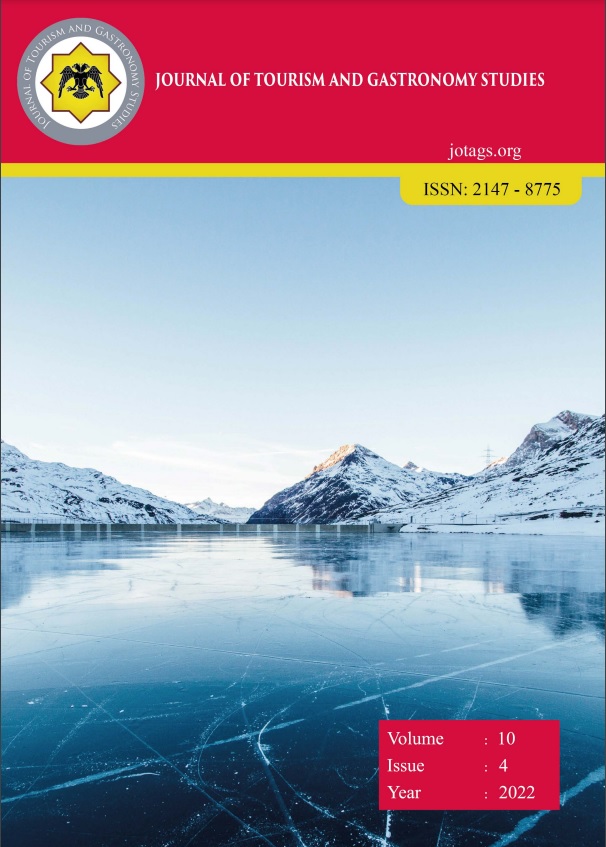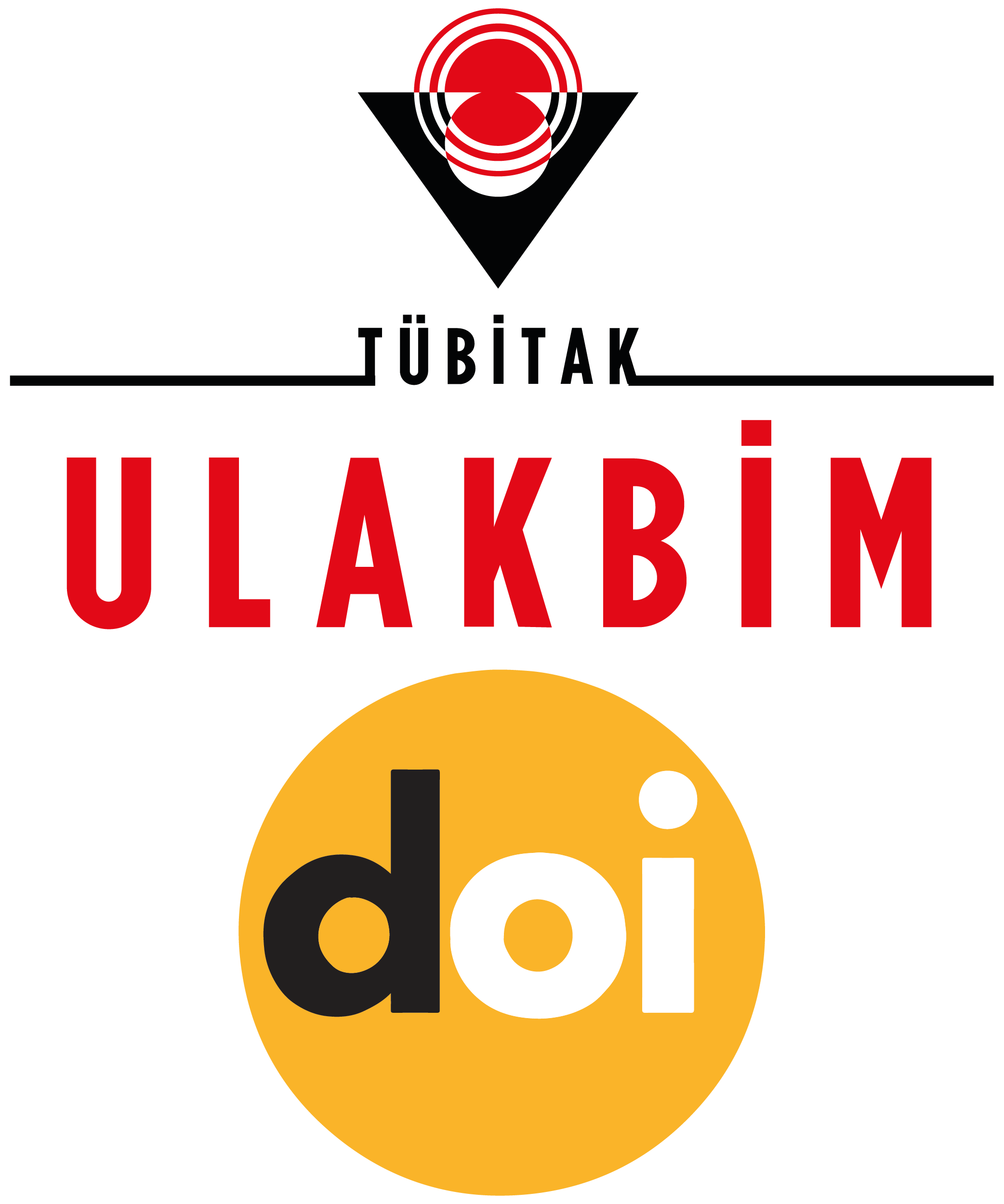Üniversite Öğrencilerinin YouTube’da ASMR Yemek İçeriği İzleme Deneyimleri ve Yeme Davranışlarına Etkisi (University Students' Experiences of Watching ASMR Food Videos and Its Effect on Eating Behaviors)
DOI:
https://doi.org/10.21325/jotags.2022.1130Keywords:
ASMR, Eating behavior, YouTube, Culinary culture, Autonomous sensory meridian response, Social mediaAbstract
Social media and technology are seen by people as a normal part of daily life. Interest in ASMR (Autonomous Sensory Meridian Response), which is an internet trend, has increased exponentially since its first appearance, and many trends related to ASMR have subsequently emerged. The present study aimed to investigate university students' experiences of watching ASMR food content on YouTube. In line with the purpose of the study, 27 students who continue their undergraduate and doctoral education were interviewed face-to-face between March-April 2022. Qualitative research method was used in the study and interview technique was applied. And semi-structured interview form were held as data collection tool. When the body mass indexes of the individuals included in the study were examined, it was concluded that the number of overweight (29.7%) and obese (14.8%) individuals should not be ignored, although half of the participants (51.8%) were in normal weight, indicating that there was no change in their eating behaviors. ASMR food videos are very effective in promoting various cuisines worldwide, especially Korean and Indian cuisine. In conclusion, ASMR food videos will contribute significantly to the promotion of traditional Turkish culinary culture and to international audiences (potential tourists) to learn that Turkish cuisine does not only consist of kebabs and its derivatives.
References
Ahirwar, R., & Mondal, P. R. (2019). Prevalence of obesity in India: A systematic review. Diabetes & Metabolic Syndrome: Clinical Research & Reviews, 13 (1), 318-321.
Akbulut, Ö. (2015). Nitel Analizler (İçerik ve Berimsel Analiz). https://docplayer.biz.tr/421042-Nitel-analizler-icerik-vebetimsel-analiz.html. (Erişim Tarihi: 03.06.2022).
Andersen, J. (2014). Now You've Got the Shiveries: Affect, intimacy, and the ASMR Whisper Community. Television & New Media, 1527476414556184. Doi:10.1177/1527476414556184.
Ardrini, D. A. M., Lubis, D., & Utami, N. W. A. (2020). I want what they’re eating”: College students’ experiences in watching food content on YouTube. Public Health and Preventive Medicine Archive (PHPMA), 8 (1), 11-16.
ASMR University. (2016). History of ASMR: Interview (Part 2) with Jennifer Allen, the woman who coined the term “ASMR” (podcast episode #9). https://asmruniversity.com/tag/jennifer-allen/. (Erişim tarihi: 23.05.2022).
Aytekin, B. A. (2019). İzleyici ve içerik etkileşimi bağlamında yeni bir youtube fenomeni olarak otonom duyusal meridyen tepki (ASMR) etkisinin deri iletkenliği ölçümü (GSR) tekniği ile incelenmesi. OPUS Uluslararası Toplum Araştırmaları Dergisi, 10 (17), s. 1568-1600.
Beşirli, H. (2010). Yemek, kültür ve kimlik. Milli Folklor, 22 (87), s. 159-169.
Brown, J. D., & Bobkowski, P. S. (2011). Older and newer media: Patterns of use and effects on adolescents’ health and well-being. Journal of Research on Adolescence, 21, 95–113.
Cupples, J., & Thompson, L. (2010). Heterotextuality and digital foreplay. Feminist Media Studies, 10, 1–17.
del Campo, M. A., & Kehle, T. J. (2016). Autonomous sensory meridian response (ASMR) and frisson: Mindfully induced sensory phenomena that promote happiness. International Journal of School & Educational Psychology, 1–7. doi:10.1080/21683603.2016.1130582.
Deliens, T., Clarys, P., De Bourdeaudhuij, I., & Deforche, B. (2014). Determinants of eating behaviour in university students: a qualitative study using focus group discussions. BMC Public Health, 14 (53).
Demirel, Ö. (2018). Protein Enerji Malnütrisyonu ve Çocukluk Çağı Obezitesi. Önay Derin, D. (Yay. Haz.). Özel Durumu Olan Çocuklarda Beslenme içinde (s. 107). Ankara: Eğiten Kitap Yayıncılık.
Dilsiz, B. (2010). Türkiye’de Gastronomi ve Turizm (İstanbul Örneği). (Yayımlanmamış Yüksek Lisans Tezi), İstanbul Üniversitesi Sosyal Bilimler Enstitüsü, İstanbul.
Doğan, E., Çekal, N., & Körükçü, Ö. (2020). A study on the examination of eating behaviors and eating habits of individuals with Down syndrome. Journal of Human Sciences, 17(2), 684-699. doi:10.14687/jhs.v17i2.5966.
Fredborg, B., Clark, J., & Smith, S. D. (2017). An examination of personality traits associated with autonomous sensory meridian response (ASMR). Frontiers in Psychology, 8. doi:10.3389/fpsyg.2017.00247.
Google Trends. (2022). Google Trend’lerde Son 5 Yıl İçinde Dünya Genelinde ‘‘ASMR Food’’ olarak aratılan Terimin Raporu. https://trends.google.com.tr/trends/explore?date=today%205-y&geo=TR&q=asmr%20food. (Erişim tarihi: 17.05.2022).
Google Trends. (2022). Google Trend’lerde Son 5 Yıl İçinde Türkiye’de ‘’ASMR Yemek’’ olarak aratılan Terimin Raporu. https://trends.google.com.tr/trends/explore?date=today%205-y&geo=TR&q=asmr%20yemek. (Erişim tarihi: 17.05.2022).
Halk Sağlığı Genel Müdürlüğü. (2017). https://hsgm.saglik.gov.tr/tr/beslenmehareket-hesaplamalar. (Erişim Tarihi: 29.04.2022).
Helianthusonfri, J. (2016). YouTube Marketing. Jakarta: PT Elex Media Komputindo.
Kaiser Family Foundation. (2010). Generation M2: Media in the Lives of 8- to 18-Year Olds. California: Menlo Park.
Kircaburun, K., Harris, A., Calado, F. & Griffiths, M. D. (2021). The psychology of mukbang watching: A scoping review of the academic and non-academic literature. International Journal of Mental Health and Addiction, 19, 1190–1213. https://doi.org/10.1007/s11469-019-00211-0.
Kivela, J., & C. Crotts, J. (2006). Tourism and gastronomy: Gastronomy's influence on how tourists experience a destination. Journal of Hospitality & Tourism Research, 30: 354.
Koreaboo. (2020). https://www.koreaboo.com/lists/top-mukbang-youtubers-earn-per-month-may-think/. (Erişim tarihi: 27.05.2022).
Kurgun, H. (2017). Gastronomi Trendleri Milenyum ve Ötesi. Ankara: Detay Yayıncılık.
Marketing Charts. (2009). https://www.marketingcharts.com/television-11195. (Erişim tarihi: 06.05.2022).
Özdemir, B. (2020). Healthy purple food in gastronomic trends. GSI Journals Serie B: Advancements in Business and Economics, 3 (1): 16-30.
Poerio, G. L., Blakey, E., Hostler, T. J., & Veltri, T. (2018). More than a feeling: Autonomous sensory meridian response (ASMR) is characterized by reliable changes in affect and physiology. PloS One, 13 (6), e0196645.
Rolling Stone (2019). https://www.rollingstone.com/culture/culture-news/asmr-super-bowl-ad-zoe-kravitz-brain-orgasm-789542/. (Erişim tarihi: 23.05.2022).
Smejka, T., & Wiggs, L. (2022). The effects of autonomous sensory meridian response (ASMR) videos on arousal and mood in adults with and without depression and insomnia. Journal of Affective Disorders, Volume 301, 60–67. https://doi.org/10.1016/j.jad.2021.12.015.
The Conversation. (2018). https://theconversation.com/asmr-videos-could-be-a-new-digital-therapy-for-mental-health-100989. (Erişim tarihi: 24.05.2022).
The Harvard Crimson. (2020). https://www.thecrimson.com/article/2020/5/7/in-defense-of-mukbangs/. (Erişim tarihi: 20.11.2022).
The Telegraph India. (2022). https://www.telegraphindia.com/culture/food/an-earful-of-culinary-experience-exploring-the-unique-asmr-food-trend/cid/1848166. (Erişim adresi: 30.04.2022).
Think With Google (2016). https://www.thinkwithgoogle.com/consumer-insights/consumer-trends/asmr-videos-youtube-trend/. (Erişim tarihi: 10.05.2022).
Vaterlaus, J. M., Patten, E. V., Roche, C., & Young, J. A. (2015). #Gettinghealthy: The perceived influence of social media on young adult health behaviors. Computers in Human Behavior, 45, 151-157.
WHO. (2000). https://apps.who.int/iris/handle/10665/42330. (Erişim tarihi: 29.04.2022).
WHO. (2021). https://www.who.int/news-room/fact-sheets/detail/obesity-and-overweight. (Erişim tarihi: 05.05.2022).
Yıldız, M., & Yılmaz, M. (2020). Gastronomi alanındaki trendlere bir bakış. Sivas Interdisipliner Turizm Araştırmaları Dergisi, (5).
Yılmaz, C., Özgürbüz, C., Şimşir, I., & Değirmenci, C. (2012). Sağlıklı Beslenme. İzmir: Ege Üniversitesi Basımevi.
Yılmaz, H., & Erden, G. (2017). Renklerin çorbaların tat algısı üzerindeki etkilerini belirlemeye yönelik bir araştırma. Journal of Tourism and Gastronomy Studies, 5/Special issue2, s. 265-275.
Downloads
Published
How to Cite
Issue
Section
License
Copyright (c) 2023 Journal of Tourism & Gastronomy Studies

This work is licensed under a Creative Commons Attribution-NonCommercial 4.0 International License.








